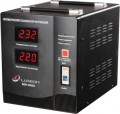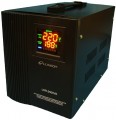Power
The maximum active load power allowed for this model.
Active power is the power that in AC appliances is spent on useful work or on heat generation. In addition to it, such devices also consume reactive power — it goes to the operation of specific components, primarily capacitors and inductors. Apparent power, denoted in volt-amperes (kilovolt-amperes), is the sum of active and reactive, see below about it. Here we note that in simple everyday situations, there is enough data on active power indicated in watts for calculations. In particular, it is this parameter that is considered the key when choosing stabilizers
for washing machines and
dishwashers : in the first case, power from 2 to 5 kW is considered optimal, in the second — from 1.8 to 2.5 kW.
Anyway, the total active power of the connected load should not exceed the figures indicated in the characteristics of the stabilizer. For a full guarantee, it's ok to take a certain margin, but this margin should not be too large — an increase in the allowable power significantly affects the dimensions, weight and price of the device. Also note that there are formulas that allow you to convert the active power consumption into total power, taking into account the type of connected electrical appliance; these formulas can be found in special sources.
Power
Maximum apparent load power allowed for this model
In electrical engineering, full power is called, which takes into account both active and reactive power; the first type of power is discussed above, and the second can be described as the effect of windings, inductors and capacitors on the operation of AC networks. Apparent power is the main parameter for calculating loads on equipment in professional electrical engineering; it is usually denoted in volt-amperes (VA), in the case of stabilizers — in kilovolt-amperes (kVA). Note that for convenience, different types of power in electrical engineering are denoted by units with different names. That is why the power in W indicated in the characteristics of the stabilizer is usually not equal to its power in VA.
When choosing a stabilizer for some household appliances, it is quite enough to have active power data, but if possible it is better to use the full one. In particular, it is this parameter that is key when looking for
a stabilizer for a refrigerator or
a stabilizer for a boiler : in the first case, 0.4 – 1 kVA is considered the optimal value, in the second — from 0.1 to 0.7 kVA. However, anyway, it is necessary to choose a specific model in such a way that its total power is not lower than the total power of the entire connected load — and it is better to have a reserve (in case of unforeseen circumstances or connecting additional eq
...uipment). At the same time, note that powerful models are distinguished by large dimensions and weight, and most importantly, high cost; therefore, it does not always make sense to chase the maximum numbers.
Also note that there are formulas that allow you to derive the optimal total power of the stabilizer based on data on active power and type of load; they can be found in special sources.Input voltage range
The voltage range at the input of the stabilizer, at which it is able to operate in normal mode and supply a constant voltage of 230 or 400 V to the load (depending on the number of phases, see above). The wider this range — the more versatile the device, the more serious power surges it can extinguish without going beyond the standard operating parameters. However, note that this parameter is not the only, and not even far from the main indicator of the quality of work: a lot also depends on the accuracy of the output voltage and the response speed (see both points below).
Also note that some models may have several modes of operation (for example, with 230 V, 230 V or 240 V output). In this case, the characteristics indicate the "general" input voltage range, from the smallest minimum to the largest maximum; the actual ranges for each particular mode will vary.
In addition, there are stabilizers that can operate outside the nominal input voltage range: with a slight deviation beyond its limits, the device provides relatively safe output indicators (also with some deviations from the nominal 230 or 400 V), but if the drop or rise becomes critical, it works appropriate protection (see below).
Output voltage accuracy (±)
The largest deviation from the nominal output voltage (230 V or 400 V, depending on the number of phases), which the regulator allows when operating in the normal input voltage range (see above). The smaller this deviation, the more efficiently the device works, the more accurately it adapts to “changes in the situation” and the less voltage fluctuations the connected load is exposed to.
When choosing for this parameter, it is worth considering first of all how demanding the connected devices are for voltage stability. On the one hand, high stability is good for any device, on the other hand, it usually means a high price. Accordingly, it usually does not make sense to buy an advanced stabilizer for an unpretentious load like light bulbs and heaters, but for sensitive devices like audio systems or computers, it can be very useful.
Protection
-
From overheating. Protection that prevents the critical temperature rise of individual components of the stabilizer - for example, in case of overload, short circuit or failure in the cooling system. When a certain temperature value is exceeded, it turns off the device in order to avoid breakdowns and fires. Such systems are especially important for semiconductor types of stabilizers - thyristor and
triac(see above). And in some models, this function can be supplemented by a temperature increase signal - it works at a temperature close to critical.
-
From high-frequency interference. This protection dampens incoming high-frequency interference, preventing them from affecting the operation of devices connected to the stabilizer. Such interference can occur, for example, from electric motors, welding machines, etc. So, in audio systems, high-frequency distortion causes an unpleasant background from the speakers. RFI protection filters out these distortions, providing a smooth sine wave output.
-
Against short circuit. A system that protects the stabilizer in the event of short circuits in the connected load. A short circuit is a situation when the resistance in the circuit becomes close to zero; this leads to a sharp increase in current strength, overloads the power grid and the stabilizer itself, and also creates a ri
...sk of breakdown or even fire. In order to avoid unpleasant consequences, appropriate protection is provided: it disconnects the load in case of a significant excess of the current in it. This feature is almost mandatory in modern stabilizers.
- From overload. Safety system in case of stabilizer overload - that is, a situation when the total power of the connected load becomes greater than the corresponding indicators of the device itself (see "Power"). The reason for this situation may be, for example, the inclusion of an additional consumer or a change in the operating mode of one of the existing ones. Unlike the short circuit described above, when overloaded, all electrical appliances work normally, the stabilizer itself is abnormal, which can lead to its failure or even fire. To avoid this, overload protection is applied. Its specific implementation may be different. In some models, the load is turned off immediately, in others - after a certain time after the warning signal, which gives the user the opportunity to reduce power consumption and avoid system tripping.
- From over / under voltage. A system that protects the device from too low or too high input voltage. A significant overshoot of the input voltage range (see above) is dangerous not only by the risk of damage to the stabilizer itself: under such conditions, the device’s capabilities are not enough to fully protect the connected load, which can result in trouble for it. And this function prevents such consequences: if the input voltage goes beyond the permissible values (they may be wider than the operating values, see “Input voltage range”), the stabilizer is disconnected from the network. At the same time, some of its functions may remain operational - for example, a voltmeter that allows you to assess the "state of affairs" in the network at the input. And in some models there is a function to automatically turn on when the voltage returns to operating limits.
